Genealogy Gems Podcast Episode 233
Genealogy Gems Podcast Episode 233
with Lisa Louise Cooke
September 2019
Listen now, click player below:
;
Please take our quick podcast survey which will take less than 1 minute. Thank you!
In this Episode
Today we’re going to take a look at what so many records and record collections have in common: they are often Lists. Now that may sound pretty straight forward, but there’s a lot more to Lists than meet the eye.
A list of names, places or other information has a lot to tell us and can be used in unique ways. Professional genealogist Cari Taplin joins me in this episode for a conversation about what is so lovely about lists.
My Summer Vacation
If you’ve been following me on Instagram – you can find me here on Instagram or by searching for genealogy gems podcast in the free Instagram app – then you know that I’ve spent a bit of my time this summer getting a taste of some of the work many of my ancestors did and probably that many of your ancestors did: farming.
Bill and I have a close friend who owns his grandfather’s 1904 homestead in North Dakota. A few years back Bill went up there to help them open it back up and get things up and running. This year we helped them harvest their crop of oats. (They even have a sign in the field that says, “These oats will grow up to be Cheerios”)
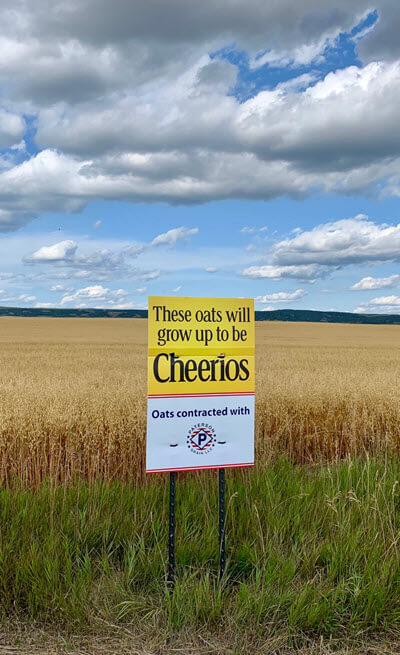
Of course, we used equipment that our ancestors may not have had. I learned to drive the combine, and I turned the field with the tractor. But in many ways, things haven’t changed all that much.
One of the things that really struck me was how the farming community out there pulls together.
Now to put this in perspective: the 240-acre homestead is about two miles down a dirt road from Canada. The house has fallen into disrepair over the decades, so our friend bought an old farmhouse in the nearby town where he grew up. That town has a population of just over 50 people!
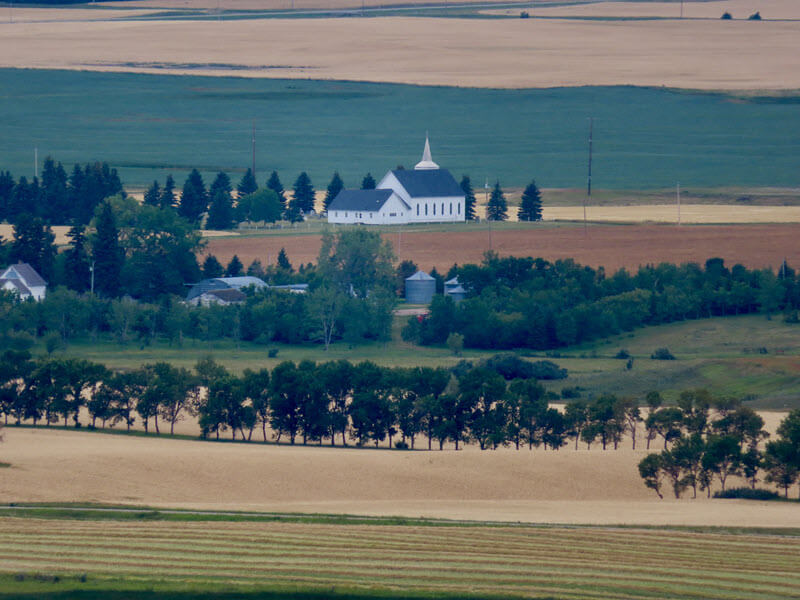
North Dakota farmland. Photo Credit: Lisa Louise Cooke, Genealogy Gems
So, we’re talking about a pretty remote location, and folks are scattered on various farms miles apart. But when a tractor was in need of repair, within the hour a neighbor would be pulling up ready to crawl under it alongside our friend to work on it till it was fixed. When a piece of equipment was needed that he didn’t have, it would soon be rolling down the road from a neighboring farm to pitch in.
Everyone had one eye on the sky at all times to watch the ever-changing weather, and there was such a commitment by all to make sure no neighbor was left with unharvested crops before a storm hit.
So even though the combines of today are motorized massive machines with air conditioning and stereos, the work ethic, the commitment and the community was unchanged from when his granddad first filed his homestead claim. Bill and I felt really blessed to be a part of it.
Think of us next time you eat your cheerios.
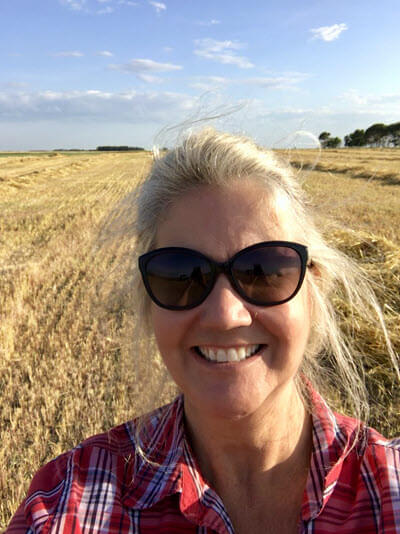
Farm selfie

MyHeritage.com is the place to make connections with relatives overseas, particularly with those who may still live in your ancestral homeland. Click the logo above to get started.
GEM: Interview with Cari Taplin
If you’ve been doing genealogy for any length of time, then you have probably encountered a list. They come in all shapes and sizes, and at first glance they may seem very straight forward.
Cari Taplin, a certified genealogist out of Pflugerville, Texas, says it’s worth taking the time to really examine lists carefully because there may be more there than meets the eye.
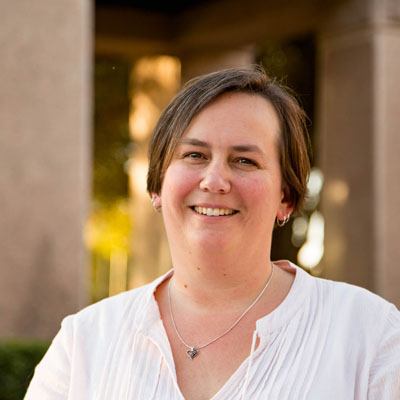
Cari currently serves on the boards of the Association for Professional Genealogists and is the Vice President of Membership for the Federation of Genealogical Societies. As the owner of GenealogyPANTS, she provides speaking, research, and consultation services, focusing on midwestern and Great Lakes states and methodology.
Types of Lists
Nearly every time we sit down to do genealogy research we run into a list. There are loads of them out there. Here’s just a starter list of the lists you might run into:
- indexes of any kind
- city directories
- tax lists
- petitions
- censuses
- church membership
- members of a club or society
- fraternal organization member lists
- community groups
- committees
- lists in newspapers like hotel registrations, letters at post office
- hospital admittances and discharges
- cemetery books
- event participants
- jurors
- estate sales
- militia rolls
- voter lists
- land lottery winners
- school class lists
- yearbooks
- agricultural lists

Census records are examples of lists
Significance of List Construction
Of course, not every list is alphabetically organized by any means. We might run into a list of prison inmates listed by number, or burial sites listed by plot or location. The information can be organized in many different ways.
Cari says that the way the list maker decided to organize the list tells us a lot about the information.
For example, a list that is alphabetized might be an indication that it is a recreated list. Other ways that lists may be constructed include chronologically or by location.
Here are follow up tasks you can do:
- Evaluate for potential error
- Locate the original source
List Explanation or Instructions
Understanding the thinking behind how the list was constructed is also important.
The U.S. Federal Census is a great example of a list that has other background documents such as the enumerator instructions. We don’t see these instructional documents unless we go looking for them. The instructions provide background on the creation of the list, and that can help us get more out of it.
Research Tip: Measuring America: The Decennial Censuses From 1790 to 2000. From that page you download the PDF of enumerator instructions.
Here’s an example of how understanding the census enumerator instructions can help you better understand how to interpret it:
In 1900 the census was answered as if it were a particular day. This means that if someone died a few days later, they may still be listed as alive in the 1900 census. If you know that they died that year, you now have more information that it was after the enumeration date.
Genealogy websites like Ancestry, FamilySearch and MyHeritage often provide background on the creation and purpose of their record collections.
Tax List example: there are laws behind them. Look up the statute. Google to find summations of tax laws at the time. Keep in mind that they might be in order of location.
When analyzing a list, ask yourself the following questions:
- What was this list created for?
- Why is it in this order?
- What does that then tell me about these people?
What’s we’re really talking about is educating ourselves
so that we’re not contributing to the errors that get out there.
It’s an investment in accuracy.
Context
It can be tempting to just scan the list, grab your ancestor out of it, and move on. But if we do that, we could be leaving a lot of genealogical gold behind.
“Evidence mining requires attention to detail, including details that might initially seem insignificant.” ––BCG, Genealogy Standards, #40, p. 24
Here are some ideas as to what we should look for:
- Sometimes it’s just a name (example: petition lists)
- There might be columns at the top – pay attention to those details for more understanding
- Other people in the list: the FAN Club (Friends, Associates, Neighbors.) Look for those names in other documents.
Organizing Your Research and the Data Collected from Lists
Cari uses spreadsheets to organize her genealogical research project data.
Come of the benefits of using a spreadsheet are that you can:
- easily sort the data
- easily manipulate the data
- visualize the data in different forms
Free Download: Read How German Address Books at Ancestry.com are Helping Bust Brick Walls and download the free spreadsheet template.
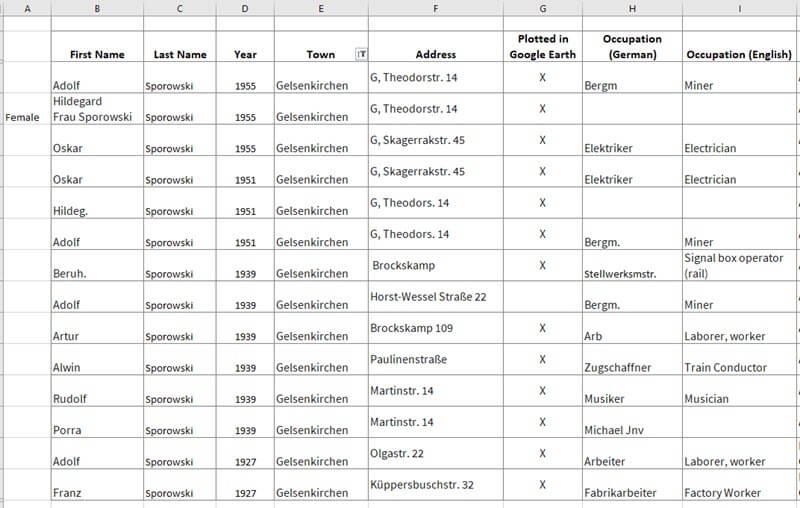
Addresses found in German Address Books marked in the spreadsheet
Explore the Bigger List
Often times you do a search, and you find a single record. But that single record is actually part of a massive internal list, an indexed list from which the search engine is pulling.
An example of this is when you run a search for your ancestor at the Bureau of Land Management website (BLM). After finding your ancestor’s record, you can then run a search by that land description to find other people who owned land and possibly lived nearby.
Watch the FamilySearch video on the batch search technique that Lisa mentioned.
What Constitutes Proof?
“Evidence mining requires attention to detail, including details that might initially seem insignificant.” – BCG, Genealogy Standards, #40, p.24
Review the Genealogical Proof Standard in the show notes for Genealogy Gems Podcast episode 232.
2 men with 1 name
When everyone in the family wants to name their children after Grandpa, you can end up with a lot people in a county with the same name. You need to tease them apart.
Questions to ask:
- Who did they associate with?
- Who were their siblings?
- Where were each of them located?
All of these things can help differentiate them. A spreadsheet is an excellent tool for this.
The Yearbook List Example
Very often the list of names is the full list of students. However, not every student necessarily had their photo taken. Count the names and then count the photos to verify you have the right person. Search the Ancestry Yearbook collection to try and find another photo of the person to compare.
Cari’s Main Message
Don’t skip over a list because it’s lacking some identifying information. You still need to record it. You may come back to it one day!
Visit Cari Online: Genealogy Pants
Profile America: The Gregorian Correction
Wednesday, September 11th. This was a day that didn’t exist in Colonial America in 1752, as the familiar calendar underwent what is called the “Gregorian correction,” switching from the ancient Julian calendar to adjust for errors accumulated over centuries.
After September 2nd, the next day was September 14th. The British parliament’s Calendar Act of 1750 had also changed New Year’s Day from March 25th to January 1st. As a result, the year 1751 had only 282 days. Since then, with leap years built in as in 2020, the calendar has remained constant.
Sources:
Calendars timeline, accessed 6/6/2019
Calendar Act
Calendar riots
Printing services, County Business Patterns, NAICS 32311
Printing employment, Annual Survey of Manufacturers, NAICS 32311
News: Watch Lisa’s new MyHeritage Education Center
Visit the MyHeritage Education Center to watch videos and read article to help you get more out of using MyHeritage. Watch the presentation at the MyHeritage Education Center: How to Find Your Family in Newspapers with SuperSearch
Download the Show Notes PDF in the Genealogy Gems Podcast app.
Genealogy Gems Premium Podcast Episode 155: Grappling with a Unique Family Legacy
In the new Genealogy Gems Premium Podcast Episode 155, Lisa Louise Cooke talks with author Sylvia Brown about coming to terms with her renowned New England family’s legacy of wealth, philanthropy–and slaveholding. Also in this episode: Facebook helps a...Genealogy Mystery Series to Die For: Genealogy Gems Book Club
May is Mystery Month, so the Genealogy Gems Book Club is spotlighting a favorite genealogical mystery series writer: Nathan Dylan Goodwin. In his latest, forensic researcher Morton Farrier finally confronts his own past.

We first met British novelist Nathan Dylan Goodwin when we featured his novel The Lost Ancestor in the Genealogy Gems Book Club. The hero, Morton Farrier, is a forensic genealogist. He’s dogged, thorough and totally likeable. Morton now appears in an entire series about his research adventures–both his professional ones and his personal ones. We think they’re all worth reading! Enjoy them individually–or grab the value bundle on Kindle.
Here’s the lowdown on the full series or Morton Farrier mysteries, in order:
Hiding the Past. In this debut novel, we meet British genealogist Morton Farrier. He’s tenacious and thorough, qualities that make him an excellent investigator–but put him in danger when he starts investigating the mysterious identity of Peter Coldrick. Despite the clear danger to himself and his tough-and-adorable fiance Juliet (a police officer), Morton won’t back off. Meanwhile, he learns a startling truth about his own roots.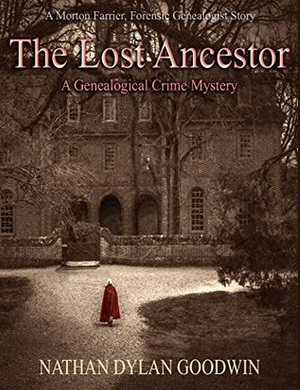
The Lost Ancestor. Morton is hired to find out what happened to his client’s great-aunt Mary, who disappeared without a trace a century ago while working as a maid at a grand English estate (gotta love the Downtown Abbey-style drama!). This is the book we featured in the Genealogy Gems Book Club, which Nathan talked about in the Genealogy Gems Podcast episode 180 (free excerpt) and the Genealogy Gems Premium Podcast #124 (subscriber-only).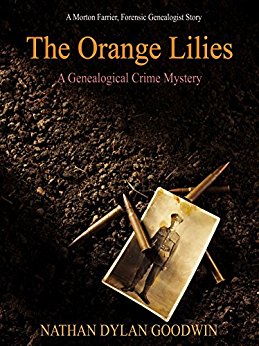
The Orange Lilies: A Morton Farrier novella. Morton confronts a long-standing mystery in his own family–one that leads him just a little closer to the truth about his personal origins. This Christmas-time tale flashes back to Christmas 1914: World War I, to a turning point in his relatives’ lives. Don’t miss it!
The America Ground. A no-man’s piece of land–formed from the sea as Hasting Harbor silted in–became home to a lawless neighborhood where a woman was killed more than 180 years ago. It falls to Morton Farrier to uncover her story. Distracted by the unfolding mystery of his own parentage, he doesn’t realize the danger he’s unwittingly stumbled into until it’s almost too late.
The Spyglass File: A Morton Farrier novella. A client’s unknown past leads Morton to a young woman’s secret mission during World War II. Her name ends up in the mysterious Spyglass File, a subject so dangerous that Morton has bad guys after him as soon as he starts prying. He may or may not get kidnapped right before he’s supposed to marry the lovely Juliette. Meanwhile, Morton anguishes over the continuing mystery of his own roots.
 The Missing Man. Morton Farrier can’t wait any longer: he must unravel the mystery of his own past. Who is his American father and why did he disappear from his mother’s life, despite letters evidencing his devotion? What, if any, role did a devastating house fire play in his disappearance? Morton and Juliet head to the east coast in the United States to confront surviving relatives, learn what they can about Harley Jacklin and help Morton come to terms with whatever he discovers.
The Missing Man. Morton Farrier can’t wait any longer: he must unravel the mystery of his own past. Who is his American father and why did he disappear from his mother’s life, despite letters evidencing his devotion? What, if any, role did a devastating house fire play in his disappearance? Morton and Juliet head to the east coast in the United States to confront surviving relatives, learn what they can about Harley Jacklin and help Morton come to terms with whatever he discovers.
Nathan joined us for a great conversation on the Genealogy Gems Premium Podcast episode #124. Click here to learn more about joining Genealogy Gems Premium website membership or click here to hear a free excerpt in Genealogy Gems Podcast episode 180).
What does Nathan Dylan Goodwin read?
On his must-read list of genealogical fiction are two we’ve mentioned on the Genealogy Gems Book Club page:
The Marriage Certificate by Stephen Molyneux. Peter, a genealogy buff, buys a marriage certificate on display at an antiques gallery. He begins researching the couple with an idea of returning the certificate to them. Eventually he uncovers several secrets, one with some money attached to it, but others are also chasing this money. Surprise twists bring the story into the present day and Peter has a chance to become a hero.
by Stephen Molyneux. Peter, a genealogy buff, buys a marriage certificate on display at an antiques gallery. He begins researching the couple with an idea of returning the certificate to them. Eventually he uncovers several secrets, one with some money attached to it, but others are also chasing this money. Surprise twists bring the story into the present day and Peter has a chance to become a hero.

 Keep up with great reading recommendations like these ones! Follow the Genealogy Gems Book Club. Click here to see what else we’ve recommended.
Keep up with great reading recommendations like these ones! Follow the Genealogy Gems Book Club. Click here to see what else we’ve recommended.




